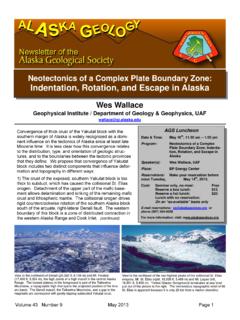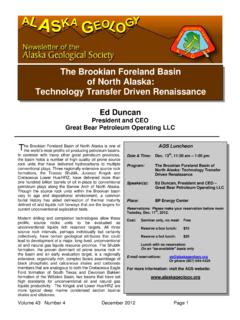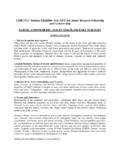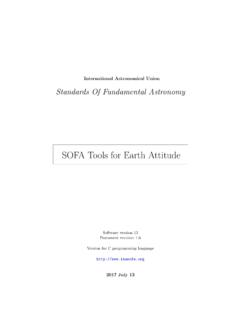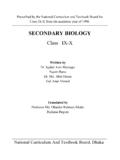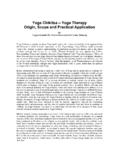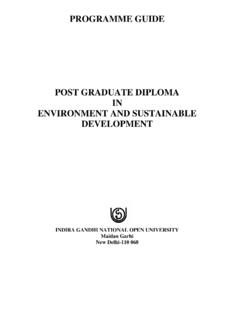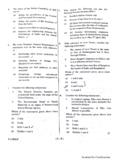Transcription of The Great Alaska Eruption of 1912
1 Volume 43 Number 2 October 2012 Page 1 John Eichelberger University of Alaska Fairbankst about noon on June 6, 1912, an Eruption broke out on the Alaska Peninsula that within two days became Earths largest since Indonesias Tambora in 1815. During the first day the flow rate exceeded 108 kg/s corresponding to a thermal output of 108 MW. By the end of the Eruption two and a half days later, about 30 km3 of pumice and ash had erupted, blanketing Kodiak with a 30-cm-thick ash layer and filling a glacial valley that became known as The Valley of Ten Thousand Smokes to a depth of 200 300 m.
2 Besides its enormity, the Eruption was remarkable for the wide range in composition of magma, the formation of an ignimbrite sheet, and the catastrophic collapse of a large volcano, Katmai, 10 km from the eruptive vent. The research and scientific debates that followed have shaped modern concepts of chemical evolution of magmas, caldera formation, and deposition from pyroclastic flows. A The Great Alaska Eruption of 1912 Katmai Caldera Volume 43 Number 2 October 2012 Page 2 AGS Luncheon Date & Time: Oct. 18th, 11:30 am 1:00 pm Program: Great Alaska Eruption of 1912 Speaker(s): John Eichelberger University of Alaska Fairbanks Place: BP Energy Center Reservations: Please make your reservation before noon Tuesday, Oct.
3 16th, 2012. Cost: Seminar only, no meal: Free Reserve a box lunch: $15 Reserve a hot lunch: $20 Lunch with no reservation: On an as-available basis only E-mail reservations: Or phone (907) 644-4429 For more information: visit the AGS website: About the Speaker: John Eichelberger has visited the site of the Great Katmai Eruption of 1912 nearly every year of the last 25, both to conduct research and to teach students from all over the world about volcanology. He holds bachelor and masters degrees in geology from MIT and a PhD in geology from Stanford. Following 17 years as research scientist and manager at Los Alamos and Sandia National Laboratories in New Mexico, he assumed the positions of Professor of Volcanology and Coordinating Scientists of Alaska Volcano Observatory at the University of Alaska Fairbanks in 1991.
4 In 2007, he left UAF for the Geological Surveys headquarters in Reston, Virginia where he managed the USGS Volcano Hazards Program. He returned to UAF in September 2012 as Dean of the Graduate School. Many of Dr. Eichelbergers publications deal with how magmas mix and degas. Other long-term interests are drilling into volcanic systems, geo-hazards, and international collaboration in geoscience education, research, and geo-risk reduction. Over the past two years he worked successfully to establish a natural hazards committee under the Bilateral Presidential Commission, with an early focus on earthquake, tsunami, and Eruption risk reduction in the Russian Far East and Alaska .
5 From the Presidents Desk: Once again, the hours after sunset are exceeding those after sunrise. We accordingly adjust our schedules and attitudes to accommodate regular yearly phenomena. I know I always seem to have something to do. Like others, Ive recently had the chain saw fired up and a few Advils downed. Let me remind you to RSVP for our luncheon presentations. And it is time to pay AGS dues. Listening to Public Radio, another nonprofit, Ive heard that several companies with geologic members will match their employees NPR memberships with matching contributions.
6 Does anybody know if that is a venue which AGS could also pursue to improve our presentations and scholarship activities? Please let me know. (continued next page) Volume 43 Number 2 October 2012 Page 3 From Fairbanks, Dr. Sarah Fowell has emailed us that the September Technical Conference was a success. Of the 19 Posters, 7 were student geology and 8 were student geophysical. The winners in each category were: Rachel Westbrook for her presentation Vegetation of the Central Beringian Lowlands: Evidence of a Glacial Refugium Found in IODP Expedition 323 Sediment co-authored by S.
7 Fowell, N. Bigelow and S. Vanlaningham. Yuning Fu for his presentation Seasonal Hydrological Loading in Southern Alaska Inferred by GPS and GRACE, and Slow Slip Events in the Southern Central Alaska Subduction Zone co-authored by J. Freymueller. Dr. Fowell has also provided a complete write up on the entire conference which is on our website. As long as were focused on educational venues, remember October 14 to 20 is Earth Science Week ( ). We all probably have something unique to contribute to the inquiries of curious minds. And we might learn something in return too.
8 Did you know that Alaska is one of 7 states with a perpetual Executive Proclamation recognizing the importance of earth sciences? And who can forget that James Ussher (1581-1656) Archbishop of Armagh and Vice Chancellor of Trinity College deduced that the world was created on October 23rd. His contemporary Sir John Lightfoot (1602-1675) vice Chancellor of Cambridge refined this to be at 9 AM (the third hour of the day). Wikipedia notes that more than a few have tried to cipher dates from Roman and other regnum records and Writ. Jose ben Halafta (2nd century CE) a Talmudic scholar also known Rabbi Yose determined the date of 3761 BC as earths origin.
9 Bede (672-735) a Monk, a teacher, and prolific writer promoted the works of Dionysius Exiguus (470 to 544; Dennis the short/humble). He estimated 3952 BC was a better estimate of the earths origin. Not only did he publish instructions on calculating the date of Easter based on the first full moon of spring, he also popularized the usage of AD and BC for dating. Quite remarkably he did all of this without the concept of zero and possibly fractions! Joseph Justus Scaliger (1540-1609) a French classical historian, scholar and critic who ran afoul of the Jesuits not long after determined the record showed the Earth appeared in 3949 BC.
10 Not to be left out, Johannes Keppler (1571-1630) the renowned astronomer/astrologer liked 3992 BC. And of course, Sir Isaac Newton (1642-1727), multitalented physicist, mathematician, philosopher, astronomer/astrologer and alchemist determined 4000 BC for the beginning of the world. Who knows for certain but maybe this is why he invented the calculus we so dearly loved to take. He also included that the earth would not end before 2060, irrespective of the hitherto undiscovered Mayans. When you consider the vagaries of their data sources and social-political situations, one common thread is that these guys are recorded in our western history for their effort.







